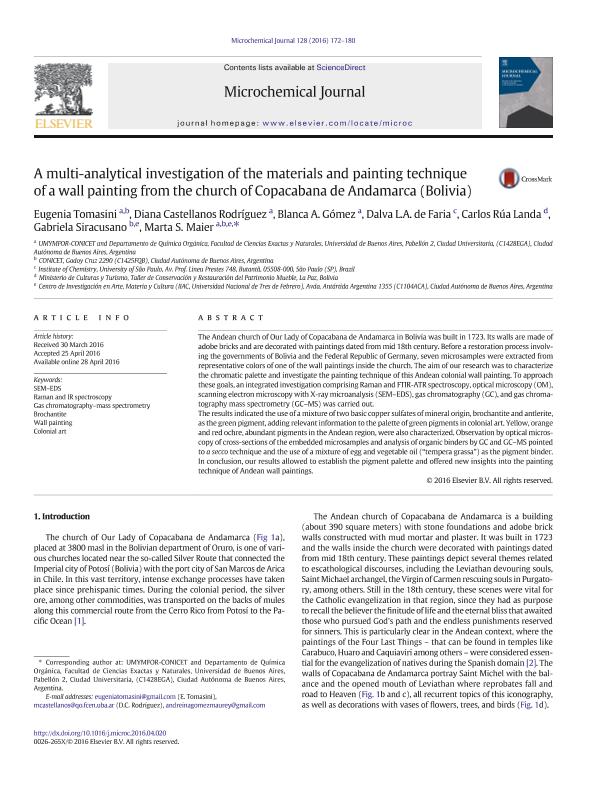Artículo
A multi-analytical investigation of the materials and painting technique of a wall painting from the church of Copacabana de Andamarca (Bolivia)
Tomasini, Eugenia Paula ; Castellanos Rodriguez, Diana Marcela
; Castellanos Rodriguez, Diana Marcela ; Gómez Romero, Blanca Andreina
; Gómez Romero, Blanca Andreina ; de Faria, Dalva L.A.; Rúa Landa, Carlos; Siracusano, Gabriela Silvana
; de Faria, Dalva L.A.; Rúa Landa, Carlos; Siracusano, Gabriela Silvana ; Maier, Marta Silvia
; Maier, Marta Silvia
 ; Castellanos Rodriguez, Diana Marcela
; Castellanos Rodriguez, Diana Marcela ; Gómez Romero, Blanca Andreina
; Gómez Romero, Blanca Andreina ; de Faria, Dalva L.A.; Rúa Landa, Carlos; Siracusano, Gabriela Silvana
; de Faria, Dalva L.A.; Rúa Landa, Carlos; Siracusano, Gabriela Silvana ; Maier, Marta Silvia
; Maier, Marta Silvia
Fecha de publicación:
05/2016
Editorial:
Elsevier Science
Revista:
Microchemical Journal
ISSN:
0026-265X
Idioma:
Inglés
Tipo de recurso:
Artículo publicado
Clasificación temática:
Resumen
The Andean church of Our Lady of Copacabana de Andamarca in Bolivia was built in 1723. Its walls are made of adobe bricks and are decorated with paintings dated from mid 18th century. Before a restoration process involving the governments of Bolivia and the Federal Republic of Germany, seven microsamples were extracted from representative colors of one of the wall paintings inside the church. The aim of our research was to characterize the chromatic palette and investigate the painting technique of this Andean colonial wall painting. To approach these goals, an Integrated investigation comprising Raman and FTIR-ATR spectroscopy, optical microscopy (OM), scanning electron microscopy with X-ray microanalysis (SEM-EDS), gas chromatography (GC), and gas chromatography mass spectrometry (GC-MS) was carried out.The results indicated the use of a mixture of two basic copper sulfates of mineral origin, brochantite and antlerite, as the green pigment, adding relevant information to the palette of green pigments in colonial art. Yellow, orange and red ochre, abundant pigments in the Andean region, were also characterized. Observation by optical microscopy of crosssections of the embedded microsamples and analysis of organic binders by GC and GC-MS pointed to a secco technique and the use of a mixture of egg and vegetable oil (?tempera grassa?) as the pigment binder.In conclusion, our results allowed to establish the pigment palette and offered new insights into the painting technique of Andean wall paintings.
Archivos asociados
Licencia
Identificadores
Colecciones
Articulos(SEDE CENTRAL)
Articulos de SEDE CENTRAL
Articulos de SEDE CENTRAL
Articulos(UMYMFOR)
Articulos de UNID.MICROANAL.Y MET.FISICOS EN QUIM.ORG.(I)
Articulos de UNID.MICROANAL.Y MET.FISICOS EN QUIM.ORG.(I)
Citación
Tomasini, Eugenia Paula; Castellanos Rodriguez, Diana Marcela; Gómez Romero, Blanca Andreina; de Faria, Dalva L.A.; Rúa Landa, Carlos; et al.; A multi-analytical investigation of the materials and painting technique of a wall painting from the church of Copacabana de Andamarca (Bolivia); Elsevier Science; Microchemical Journal; 128; 5-2016; 172-180
Compartir
Altmétricas



